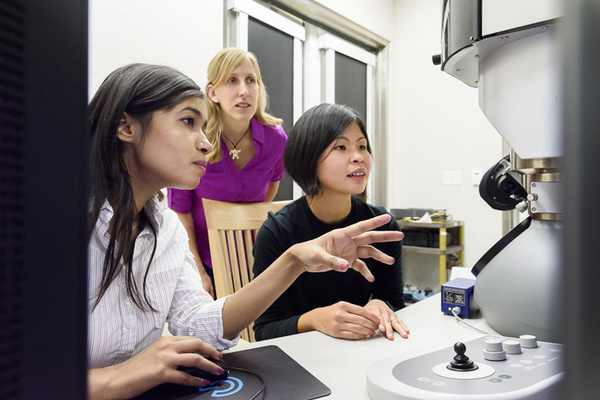|
in the underground dionne lab, well below the quad at stanford university, a group of researchers have been studying nanoparticle reactions to capture real-time visualizations of intercalation-driven phase transitions, hydrogen atoms moving in and out of palladium, which is analogous to how ions flow during the charging and discharging of battery electrodes.

using advanced electron microscope techniques, (left to right) graduate student fariah hayee, professor jen dionne
and senior research scientist ai leen koh captured extremely high-resolution video of atoms moving
in and out of nanoparticles. (l.a. cicero)
the study, according to a report on the stanford website, used palladium nanocubes ranging in size from 15-80 nanometers and placed within an electron microscope. it was known that hydrogen would change the dimensions of the nanocubes and their electrical properties and, using scanning transmission electron microscopy and electron energy loss spectroscopy, the researchers hope to capture this process.
after months of work that at times required spending more than 30 consecutive hours documenting results, the researchers had “detailed, real-time videos of the changes in the [nano]particle as hydrogen was introduced.”
once the initial stage was captured, the researchers stopped the hydrogenation process by dropping the nanocubes into an ice bath of liquid nitrogen at a temperature of -280°f and taking dark-field images to see detailed structural changes.
a major observation that the scientists discovered, and one that holds promise for nanoparticle energy storage technologies, was that the palladium self-healed. once the nanocubes had absorbed as much hydrogen as they could, the nanocubes regained the perfect crystallization that they had prior to hydrogen being introduced. this was described as the imperfections being “pushed out” of the nanoparticle.
the article concluded, “it’s likely that the future of storage will rely on new chemistries and the findings of this research, including the microscopy techniques the researchers refined along the way, will apply to nearly any solution in those categories.”
the research was published in nature communications. the abstract stated:
“many energy storage materials undergo large volume changes during charging and discharging. the resulting stresses often lead to defect formation in the bulk, but less so in nanosized systems. here, we capture in real time the mechanism of one such transformation—the hydrogenation of single-crystalline palladium nanocubes from 15 to 80 nm—to better understand the reason for this durability.
“first, using environmental scanning transmission electron microscopy, we monitor the hydrogen absorption process in real time with 3 nm resolution. then, using dark-field imaging, we structurally examine the reaction intermediates with 1 nm resolution. the reaction proceeds through nucleation and growth of the new phase in corners of the nanocubes.
“as the hydrogenated phase propagates across the particles, portions of the lattice misorient by 1.5%, diminishing crystal quality. once transformed, all the particles explored return to a pristine state. the nanoparticles’ ability to remove crystallographic imperfections renders them more durable than their bulk counterparts.”
|